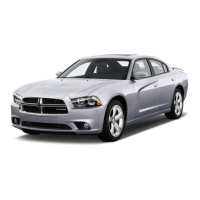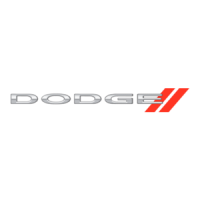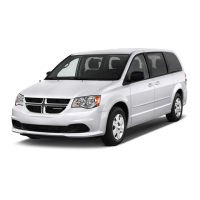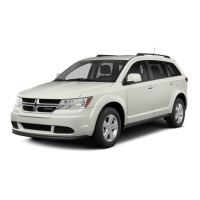Do you have a question about the Dodge 2014 CHARGER and is the answer not in the manual?
This Owners Manual contains WARNINGS against operating procedures that could result in a collision or bodily injury.
Any modifications or alterations to this vehicle could seriously affect its roadworthiness and safety.
Your vehicle uses a keyless ignition system. This system consists of a Key Fob with Remote Keyless Entry (RKE) transmitter and a Keyless Ignition Node (KIN).
The Sentry Key® Immobilizer system prevents unauthorized vehicle operation by disabling the engine.
The RKE system allows you to lock or unlock the doors, open the trunk, or activate the Panic Alarm from distances up to approximately 66 ft (20 m).
This system uses the Remote Keyless Entry (RKE) transmitter to start the engine conveniently from outside the vehicle.
Some of the most important safety features in your vehicle are the restraint systems.
Radar-based sensors in rear fascia detect vehicles in blind spot zones.
Aids drivers backing out of parking spaces by detecting oncoming vehicles.
Voice-activated, hands-free, in-vehicle communications system.
Voice-activated, hands-free, in-vehicle communications system.
Control radio, satellite radio, disc player, SD Card, USB/iPod®, and SiriusXM Travel Link.
Takes over accelerator operations at speeds > 25 mph (40 km/h) for cruising.
Maintains distance between vehicles using radar sensor; enhances driving convenience.
Provides visual and audible indications of distance to detected obstacles when backing up.
Explains each gauge, indicator, and telltale light in the instrument cluster.
Driver-interactive display in instrument cluster providing vehicle information.
Automatic oil change indicator reminds driver for scheduled maintenance.
Accesses programmable features via soft and hard keys.
Includes Front Collision Warning (FCW) sensitivity and ParkSense® settings.
Allows setting FCW sensitivity to Far, Near, or Off.
Scans for objects behind vehicle in REVERSE and provides audible/visual alerts.
Allows setting Blind Spot Alert to Off, Lights, or Lights and Chime.
Assists driver starting on a hill by maintaining brake pressure after brake pedal release.
Allows locking/unlocking vehicle doors without pressing RKE transmitter buttons.
Adjust seat, mirrors, fasten seat belt, and instruct occupants before starting vehicle.
Driver-interactive feature for manual shift control, maximizing engine braking.
Explains active on-demand AWD system that redirects torque for optimum traction.
Tips on acceleration and traction to maintain control on wet, icy, or snowy surfaces.
Cautions and warnings for driving through water to ensure safety and prevent damage.
How to apply/release parking brake and its relation to Brake Warning Light.
Increases stability/performance by controlling hydraulic pressure to prevent wheel lock-up.
Includes ABS, TCS, BAS, ESC systems for enhanced stability and control.
Monitors wheel spin, applies brake pressure to slipping wheels for better acceleration/stability.
Optimizes braking capability during emergency maneuvers by detecting and applying optimum pressure.
Enhances directional control and stability by correcting oversteering and understeering.
Assists driver starting on a hill by maintaining brake pressure after brake pedal release.
Provides information on tire markings, treadwear, traction, and temperature grades.
Warns driver of low tire pressure based on recommended cold placard pressure.
TPM Telltale Light illuminates, EVIC displays LOW TIRE message and graphic when tire pressure is low.
Indicates system fault, flashing TPM Telltale Light, and SERVICE TPM SYSTEM message.
Information for Flexible Fuel Vehicles (FFV) compatible with gasoline or E-85 fuel.
Exhaust gases contain deadly carbon monoxide (CO); follow precautions to prevent poisoning.
Located in switch bank, press switch to turn on/off; flashes all directional turn signals.
Actions to reduce overheating potential, like slowing down or turning off A/C.
Safety warnings and instructions for changing a tire, including jack placement.
Safe procedures for jump-starting using jumper cables or a portable booster pack.
Procedure to manually release transmission from PARK for towing when battery is dead.
Describes procedures for towing a disabled vehicle using a commercial wrecker service.
Monitors emissions, engine, and transmission systems; turns on Malfunction Indicator Light (MIL) if service needed.
Recommends authorized dealers for expert service, special tools, and information.
Instructions for checking engine oil level for 3.6L and 5.7L engines.
Provides warnings and cautions for working with the cooling system and engine coolant.
Assures brake system performance; periodically inspect all brake system components.
Check fluid level immediately if brake system warning light indicates failure.
Details selection of proper transmission fluid for optimum performance and life.
Details automatic oil change indicator system and service reminders.
Includes changing oil/filter, rotating tires, inspecting battery, brakes, and exhaust system.
Provides scheduled maintenance based on mileage or time passed.
Manufacturer and dealer are interested in customer satisfaction; recommends authorized dealer service.
Instructions for reporting vehicle defects to NHTSA and notifying the manufacturer.
This Owners Manual contains WARNINGS against operating procedures that could result in a collision or bodily injury.
Any modifications or alterations to this vehicle could seriously affect its roadworthiness and safety.
Your vehicle uses a keyless ignition system. This system consists of a Key Fob with Remote Keyless Entry (RKE) transmitter and a Keyless Ignition Node (KIN).
The Sentry Key® Immobilizer system prevents unauthorized vehicle operation by disabling the engine.
The RKE system allows you to lock or unlock the doors, open the trunk, or activate the Panic Alarm from distances up to approximately 66 ft (20 m).
This system uses the Remote Keyless Entry (RKE) transmitter to start the engine conveniently from outside the vehicle.
Some of the most important safety features in your vehicle are the restraint systems.
Radar-based sensors in rear fascia detect vehicles in blind spot zones.
Aids drivers backing out of parking spaces by detecting oncoming vehicles.
Voice-activated, hands-free, in-vehicle communications system.
Voice-activated, hands-free, in-vehicle communications system.
Control radio, satellite radio, disc player, SD Card, USB/iPod®, and SiriusXM Travel Link.
Takes over accelerator operations at speeds > 25 mph (40 km/h) for cruising.
Maintains distance between vehicles using radar sensor; enhances driving convenience.
Provides visual and audible indications of distance to detected obstacles when backing up.
Explains each gauge, indicator, and telltale light in the instrument cluster.
Driver-interactive display in instrument cluster providing vehicle information.
Automatic oil change indicator reminds driver for scheduled maintenance.
Accesses programmable features via soft and hard keys.
Includes Front Collision Warning (FCW) sensitivity and ParkSense® settings.
Allows setting FCW sensitivity to Far, Near, or Off.
Scans for objects behind vehicle in REVERSE and provides audible/visual alerts.
Allows setting Blind Spot Alert to Off, Lights, or Lights and Chime.
Assists driver starting on a hill by maintaining brake pressure after brake pedal release.
Allows locking/unlocking vehicle doors without pressing RKE transmitter buttons.
Adjust seat, mirrors, fasten seat belt, and instruct occupants before starting vehicle.
Driver-interactive feature for manual shift control, maximizing engine braking.
Explains active on-demand AWD system that redirects torque for optimum traction.
Tips on acceleration and traction to maintain control on wet, icy, or snowy surfaces.
Cautions and warnings for driving through water to ensure safety and prevent damage.
How to apply/release parking brake and its relation to Brake Warning Light.
Increases stability/performance by controlling hydraulic pressure to prevent wheel lock-up.
Includes ABS, TCS, BAS, ESC systems for enhanced stability and control.
Monitors wheel spin, applies brake pressure to slipping wheels for better acceleration/stability.
Optimizes braking capability during emergency maneuvers by detecting and applying optimum pressure.
Enhances directional control and stability by correcting oversteering and understeering.
Assists driver starting on a hill by maintaining brake pressure after brake pedal release.
Provides information on tire markings, treadwear, traction, and temperature grades.
Warns driver of low tire pressure based on recommended cold placard pressure.
TPM Telltale Light illuminates, EVIC displays LOW TIRE message and graphic when tire pressure is low.
Indicates system fault, flashing TPM Telltale Light, and SERVICE TPM SYSTEM message.
Information for Flexible Fuel Vehicles (FFV) compatible with gasoline or E-85 fuel.
Exhaust gases contain deadly carbon monoxide (CO); follow precautions to prevent poisoning.
Located in switch bank, press switch to turn on/off; flashes all directional turn signals.
Actions to reduce overheating potential, like slowing down or turning off A/C.
Safety warnings and instructions for changing a tire, including jack placement.
Safe procedures for jump-starting using jumper cables or a portable booster pack.
Procedure to manually release transmission from PARK for towing when battery is dead.
Describes procedures for towing a disabled vehicle using a commercial wrecker service.
Monitors emissions, engine, and transmission systems; turns on Malfunction Indicator Light (MIL) if service needed.
Recommends authorized dealers for expert service, special tools, and information.
Instructions for checking engine oil level for 3.6L and 5.7L engines.
Provides warnings and cautions for working with the cooling system and engine coolant.
Assures brake system performance; periodically inspect all brake system components.
Check fluid level immediately if brake system warning light indicates failure.
Details selection of proper transmission fluid for optimum performance and life.
Details automatic oil change indicator system and service reminders.
Includes changing oil/filter, rotating tires, inspecting battery, brakes, and exhaust system.
Provides scheduled maintenance based on mileage or time passed.
Manufacturer and dealer are interested in customer satisfaction; recommends authorized dealer service.
Instructions for reporting vehicle defects to NHTSA and notifying the manufacturer.
| Brand | Dodge |
|---|---|
| Model | 2014 CHARGER |
| Category | Automobile |
| Language | English |











